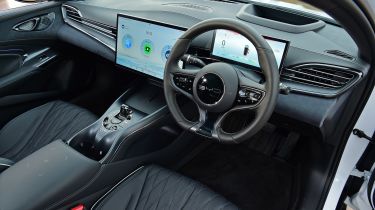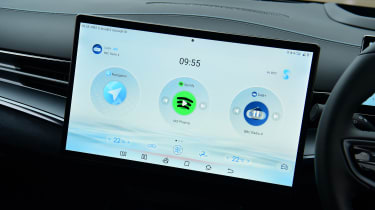BYD Seal - Interior, design & technology
A great balance of high-end technology with the quality materials that are expected of a premium car

The exterior design of the BYD Seal is handsome, and looks sleek enough to cut through the air with maximum efficiency. You have a choice of four standard metallic colours, plus two premium paint colour offerings for just under £900 – which is quite reasonable given that such an option on the Tesla Model 3 is an excessive £2,000.
Given that the Seal has been priced to compete with premium electric offerings in the class rather than trade on value like its cheaper sibling, the BYD Dolphin, you’d expect the interior to be of a certain standard. Fortunately, the Seal doesn’t disappoint.
What is the BYD Seal like inside?
Inside, the wraparound dashboard design of the BYD Seal feels more sporty than some of rivals, and we appreciate the supplementary 10.25-inch screen in front of the driver, which puts important information such as speed and trip data right where you need it, rather than off to the side like in the Model 3, which relies on its central screen. The top-of-the-range Excellence trim goes further by providing a head-up display that projects your speed on to the windscreen within the driver’s line of sight.
The glass roof helps make the all-black interior less sombre, but if you want something a little more distinctive, you can also choose the Tahitian Blue alternative.
What is the interior quality like?
Quality is good throughout, and the soft-touch materials used across the top of the door cards are particularly classy. The seats feel suitably plush both front and rear, and following the recent revisions to the Tesla Model 3, those front seats are heated and ventilated as standard. The latter will be a welcome feature in summer with the standard-fit glass roof, which floods the cabin with light.
Sat-nav, stereo and infotainment
The infotainment system is a familiar one from other BYD models, and lifted wholesale from the Atto 3; the 15.6-inch rotating display runs on the same super-fast processor that makes it responsive to your inputs. We’re not entirely sure of the need for a rotating screen and its additional complication, though. After the initial interest of watching it rotate on its axis, some might prefer to keep it in its landscape orientation all the time so that the screen doesn’t obstruct your forward view.
There is a handy shortcut to some basic climate control adjustments — such as the temperature controls — that can be made via a menu in the digital driver’s instrument cluster and the buttons on the steering wheel. This saves you from delving into the menus within the central touchscreen, but it’s still a shame that you have to exit whatever screen you’re on within the main display to access all of the climate control functions. We can’t help but think that dedicated buttons would be even less distracting for drivers.
The standard sound system is a 12-speaker sound system is by Danish hi-fi brand Dynaudio, and it’s superb, with plenty of power and great quality. You can stream music through it using either Apple CarPlay or Android Auto, and you can keep your devices charged with the two wireless charging pads provided.









